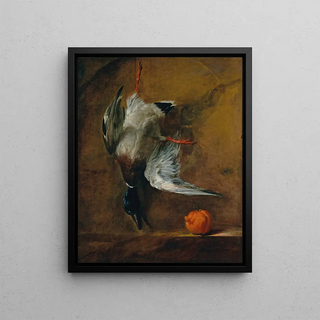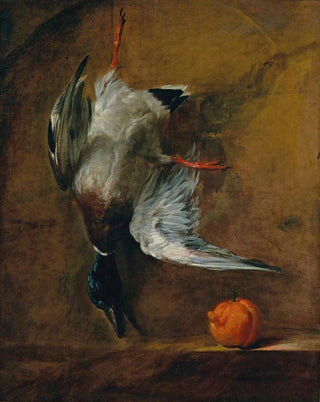Art print | A mallard and a bitter orange - Jean Siméon Chardin


View from behind

Frame (optional)
In the fascinating world of 18th-century French painting, the art print "A Mallard and a Bitter Orange" by Jean Siméon Chardin stands out for its delicacy and depth. This composition, featuring a wild duck and a citrus fruit, goes beyond a simple still life. It evokes reflection on the fleeting beauty of life and the richness of gustatory and visual sensations. Through this work, Chardin invites us to savor the simple pleasures of everyday life while offering an introspective look at the very nature of art.
Style and uniqueness of the work
Chardin's style is characterized by striking realism, where every detail is carefully observed and rendered with remarkable precision. In "A Mallard and a Bitter Orange," the texture of the duck's feathers is depicted with such meticulousness that one can almost feel their softness. The subtly diffused light creates a play of shadows and reflections that gives the entire piece an intimate atmosphere. The bitter orange, meanwhile, adds a vibrant splash of color that contrasts with the darker hues of the plumage. This chromatic choice, far from being trivial, highlights the duality between life and death, between the innocence of a frozen moment and the inevitability of existence. Chardin also masters the art of composition, guiding the viewer's gaze toward the center of the canvas, where the main elements are located, while leaving enough space for the imagination to flourish.
The artist and his influence
Jean Siméon Chardin, an emblematic figure of the 18th century, is often regarded as the master of still life. His innovative approach influenced many artists, both of his time and subsequent generations. Moving away from Baroque conventions, Chardin infused new life into genre painting by emphasizing simplicity and authenticity. His work transcends time, evoking universal emotions that still resonate today. The themes of daily life, work, and simple pleasures he explores find echoes in artistic movements

Matte finish

View from behind

Frame (optional)
In the fascinating world of 18th-century French painting, the art print "A Mallard and a Bitter Orange" by Jean Siméon Chardin stands out for its delicacy and depth. This composition, featuring a wild duck and a citrus fruit, goes beyond a simple still life. It evokes reflection on the fleeting beauty of life and the richness of gustatory and visual sensations. Through this work, Chardin invites us to savor the simple pleasures of everyday life while offering an introspective look at the very nature of art.
Style and uniqueness of the work
Chardin's style is characterized by striking realism, where every detail is carefully observed and rendered with remarkable precision. In "A Mallard and a Bitter Orange," the texture of the duck's feathers is depicted with such meticulousness that one can almost feel their softness. The subtly diffused light creates a play of shadows and reflections that gives the entire piece an intimate atmosphere. The bitter orange, meanwhile, adds a vibrant splash of color that contrasts with the darker hues of the plumage. This chromatic choice, far from being trivial, highlights the duality between life and death, between the innocence of a frozen moment and the inevitability of existence. Chardin also masters the art of composition, guiding the viewer's gaze toward the center of the canvas, where the main elements are located, while leaving enough space for the imagination to flourish.
The artist and his influence
Jean Siméon Chardin, an emblematic figure of the 18th century, is often regarded as the master of still life. His innovative approach influenced many artists, both of his time and subsequent generations. Moving away from Baroque conventions, Chardin infused new life into genre painting by emphasizing simplicity and authenticity. His work transcends time, evoking universal emotions that still resonate today. The themes of daily life, work, and simple pleasures he explores find echoes in artistic movements






